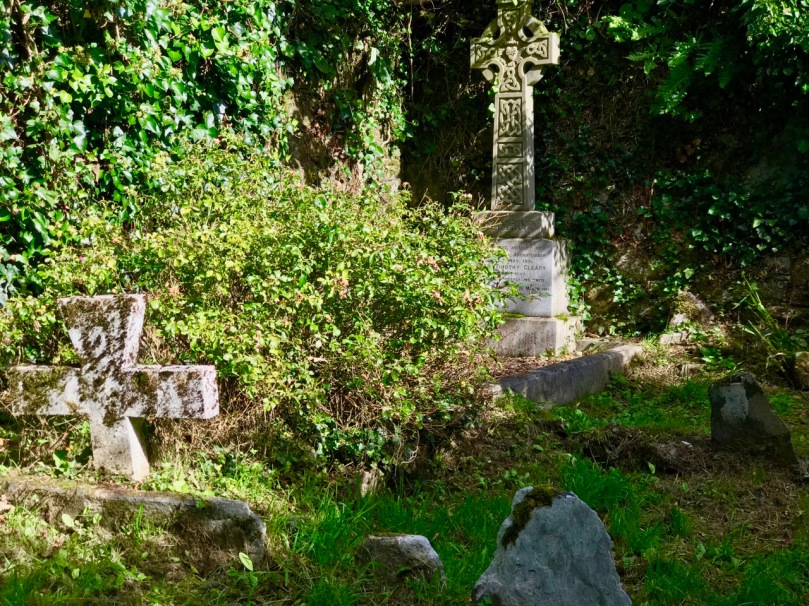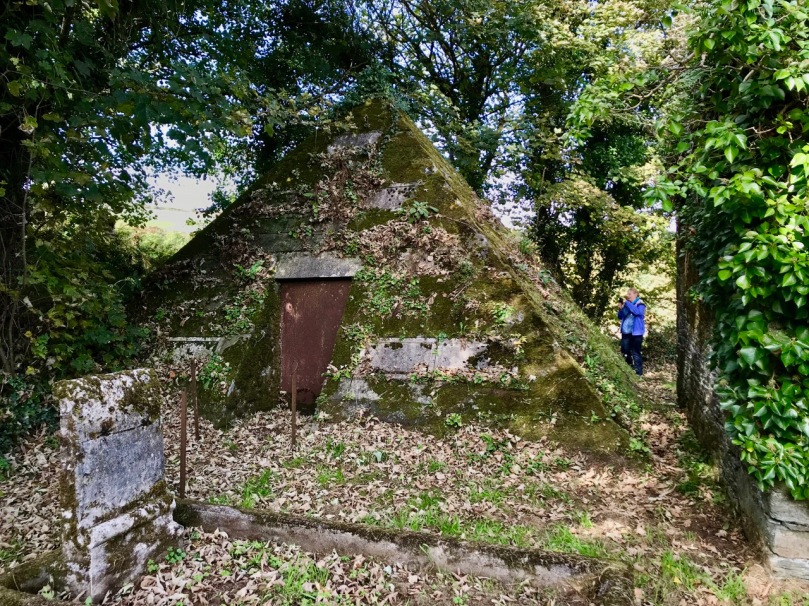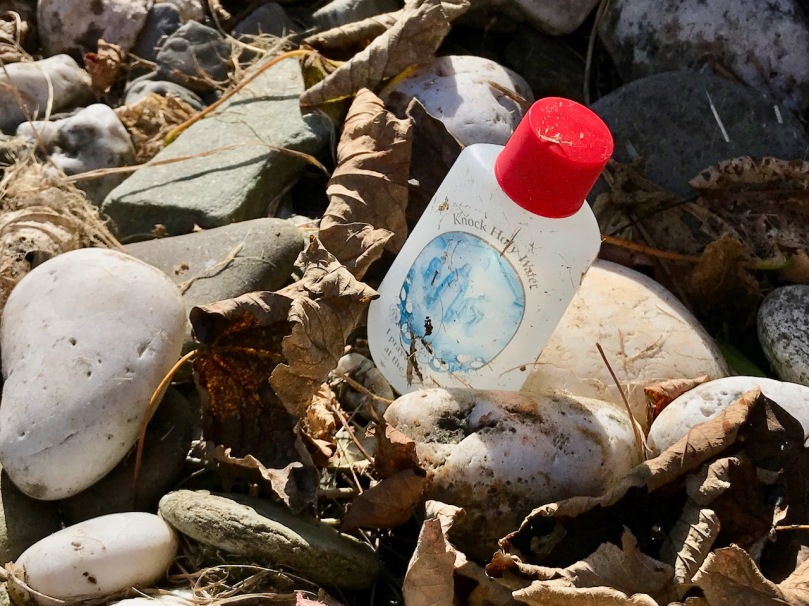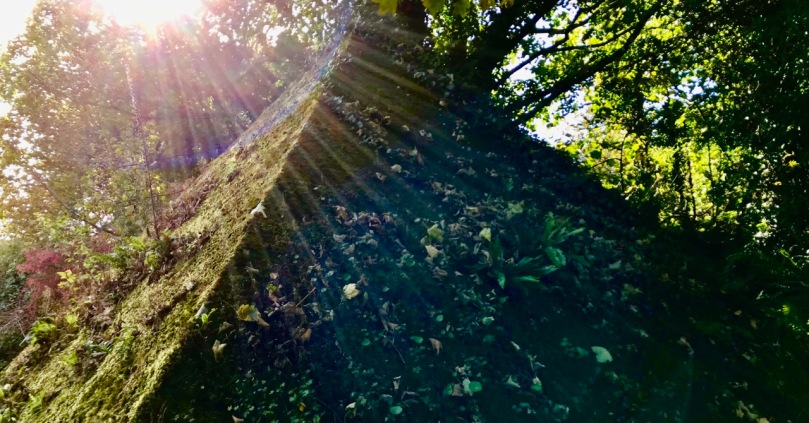In our travels we always have an eye open for signposts, especially those that point down leafy, narrow boreens: there’s probably some piece of almost lost history at the end of every one. We were beckoned, last week, by a fading cast iron plate written in ‘old Irish’ – Reilig – and the English word Cemetery. It was in a remote spot, and indicated a long, green lane with a gate in the distance. There had to be something there for us!
We were in West Cork, just by the little harbour of Glandore (in Irish Cuan D’Ór – Harbour of Gold). The green boreen took us down to an old burial ground which surrounds the ruins of a church dating, probably, to the 12th century. Around this are ancient stones – marked and unmarked – which signify the resting places of generations. It seems an idyllic place to rest, right off the beaten track, with only the sounds of nature to enhance the peace.
‘As quiet as the grave’ might be an apt expression in this place where we spent half an afternoon and saw no living soul. But the physical evidence of those who had passed was constantly fascinating. In Ireland, the simplest of grave markers is just an undressed stone firmly embedded in the soil. To us, they look random and rough, but it is said that every stone is chosen for a particular shape which is always remembered by the family who set it, and who passed the knowledge on – no markers were needed as long as that memory continued. Other stones are inscribed, although these are fewer – and some are particularly fine: a Celtic cross which dates to 1931, for example.
So far, our explorations in the Old Cemetery were typical of many another burial ground, but as we walked around the back of the ruined church we were astonished to see something we have never come across before in Ireland – a large pyramid!
You get a sense of the scale of this construction by the figure in the picture above. No Giza, perhaps, but nevertheless something monumental and unexpected in this out-of-the-way corner of West Cork. It isn’t alone, as right next to it is another mausoleum (for a mausoleum is the pyramid’s purpose): an ivy-clad masonry stronghold, huge and impenetrable.
The two vast tombs stand side by side (above) in an odd juxtaposition. We scratched our heads in wonder and searched for clues of names and dates while we were there in the churchyard and, later, in records online. Very little is revealed. There are several inscriptions set on carved stone plaques on the pyramid – all impossible to read because of the moss and lichen growth. Over the iron doorway is a lintel inscribed with – I believe – the name John Hussey de Burgh.
Later searches revealed the following:
. . . John de Burgh was born on 10 June 1822 and died 25 April 1887. Page 159 of The Calendar of Wills and Administration 1858-1922 in the National Archives of Ireland records that the will of “John Hamilton Hussey de Burgh late of Kilfinnan Castle Glandore County Cork Esquire”, who died on 25 April 1887 at the same place, was proved at Cork on 6 July 1887 by “Louis Jane de Burgh Widow and FitzJohn Hussey de Burgh the Executors”. Effects £1,246 11s 1d . . .
Kilifinnan Castle (a replacement built on the site of a structure dating from 1215) is a short distance to the south of the old cemetery, and it is highly likely that John Hamilton is the de Burgh commemorated on the pyramid. Apparently, he had seven children so it is likely that at least some of the other plaques would refer to these. The large stone-block tomb was giving up no secrets, with no apparent entrance and no plaques. There are signs that the burial ground is still visited and kept tidy.
We had to tear ourselves away from Glandore’s Old Cemetery: it is a beautiful and peaceful place. We didn’t much increase our knowledge of the history of the settlement itself, although the 1861 C of I Christ Church (Kilfaughnabeg – The Little Church of Fachtna) above the bay has a display of local lore and tales and is in any case well worth a visit: the only approach to it is through a tunnel hewn from a rock face.
Our explorations in the Reilig left us with questions to be answered: not least, what was the inspiration for the pyramid, which seems so alien in far away West Cork?
















Robert, I grew up in Glandore but we hadn’t the Hussey tag, many of our distant relatives lay at rest there, we played around there as kids and often peeked in the iron door which was slightly open then. John Hamilton
LikeLiked by 1 person
Very brave to peek in that door, John – I bet it led to some stories…
LikeLike
Hi, you might find this website interesting. There was some funding a few years ago to survey the older graveyards and a local group worked their way round our local ones. https://historicgraves.com/graveyard/glandore-old-cemetery/co-grod
LikeLiked by 1 person
Thank you, Susan – good information. I can’t see anything there about the large square mausoleum that’s right next door to the pyramid. That is also intriguing. There are no inscriptions on it….
LikeLike
My father, who was born in Glandore, tells me the mausoleum was built for the Roche family. Unfortunately he had no more information about them.
LikeLike
Yes absolutely fascinating! I have never heard of this type of burial in Ireland so I’m learning, and for it to be so close to where we live is super as I definitely plan to visit this graveyard during this summer. Lovely photos as well Robert!
LikeLiked by 1 person
Thank you, Gaia. It is such an atmospheric place – well worth a visit.
LikeLiked by 1 person
This brought up a vague 20-year-old memory of another ‘pyramid grave’ in a reilig south of Union Hall near the sea.
LikeLiked by 1 person
Probably Myross – which is the subject of my next post!
LikeLike
A wonderful place, and beautifully captured by your pics. It’s no bad thing (in my view) that some history remains clouded and hidden, especially in places like this. No putting up interpretation boards please 🙂
LikeLiked by 1 person
I agree, Roy – although I do find ‘interpretation boards’ useful at times, but they need to be sensitively placed (and well designed!). I certainly wouldn’t want to see one within this burial ground…
LikeLike
Robert, Another memory has bubbled to the surface of my aged brain. The dates show that the pyramid was built some few years after De Hussey’s actual burial, BUT it was one of his sons who was the architect. That’s all! JB.
LikeLiked by 1 person
Thank you, John – yes, that fits in better with the information I found. The architect Hussey de Burgh lived in Cork, whereas John Hamilton lived in the castle in Glandore, which is why I assumed that it is his burial place. It’s certainly very possible that the architect (who might have been John Hamilton’s son or nephew) designed the pyramid and – as it seems to be a family mausoleum – indeed, he might be in there too! It’s a pity the other plaques are illegible, but we will go back another day and try to decipher them.
LikeLike
Hi Robert, We came upon these monuments about 18 years ago. Looked up the occupant and traced him as an architect who worked in a small way in Cork (hence the grandiosity) but I did not make a note of where I found it. You can probably trace him. Regards, John and Sonia.
LikeLiked by 1 person
This article brought back fond memories of my month in Glandore this past summer while visiting in West Cork. Fascinating and beautiful place!
LikeLiked by 1 person
It’s very special, Tom – as is most of West Cork!
LikeLike
Heading to Schull on Thurs Finola and already looking forward to exploring the beautiful old graveyard in Glandore. Thanks as ever for the wonderful description and photos! Con will be fascinated..
LikeLiked by 1 person
You will love the graveyard – hope you have a sunny day! Robert
LikeLike
There is a similar pyramid tomb in the Church of Ireland cemetery in Naas
LikeLiked by 1 person
Thank you John – next time we are in Naas… Pyramids could become a fixation!!
LikeLike
Great story and detective work, Robert. We visited the Dromberg Stone Circle, heading west, and drove through Glandore.
LikeLiked by 1 person
Thank you, Michael – we hope you enjoyed West Cork as much as we do!
LikeLiked by 1 person
absolutely….would love to go back someday
LikeLiked by 1 person
It is an astonishing thing to come across – slightly ironic that the person this fine mausoleum is dedicated to cannot (yet) be definitely traced but I suspect you have the right man. Always worth going down small green tracks in my opinion!
LikeLiked by 1 person
It certainly is… We are all well experienced in that!
LikeLike
Utterly fascinating – and none the poorer for leaving unanswered some of the questions raised! Thank you so much for sharing. Stunning autumnal images too.
LikeLiked by 1 person
Thank you, Caroline. I, too, like enigmas!
LikeLike
Wow! What a splendid find! I read your blog as often as I can, learning about West Cork. I just returned from Ballydehob, Ballybane, and I found my gggrandparents’ headstone in an old cemetery in Kilcoe. There were also ruins of an old church there, but I could not find out its name.
But it was a beautiful resting place for these souls.
Thank you for sharing your adventures with me!
– Kathleen
LikeLiked by 1 person
Thank you, Kathleen. We frequently visit the medieval church at Kilcoe – right down opposite the castle – as it’s such an atmospheric place. It’s great for you to have a connection there. We have never discovered any dedication for that church.
LikeLike
Just fascinating 👌🏼
LikeLiked by 1 person
Yes, Sean – and very unexpected!
LikeLike
A lovely adventure! A good reminder to always venture down those pathways..
LikeLiked by 1 person
Happy to share that adventure with you, Carol!
LikeLike